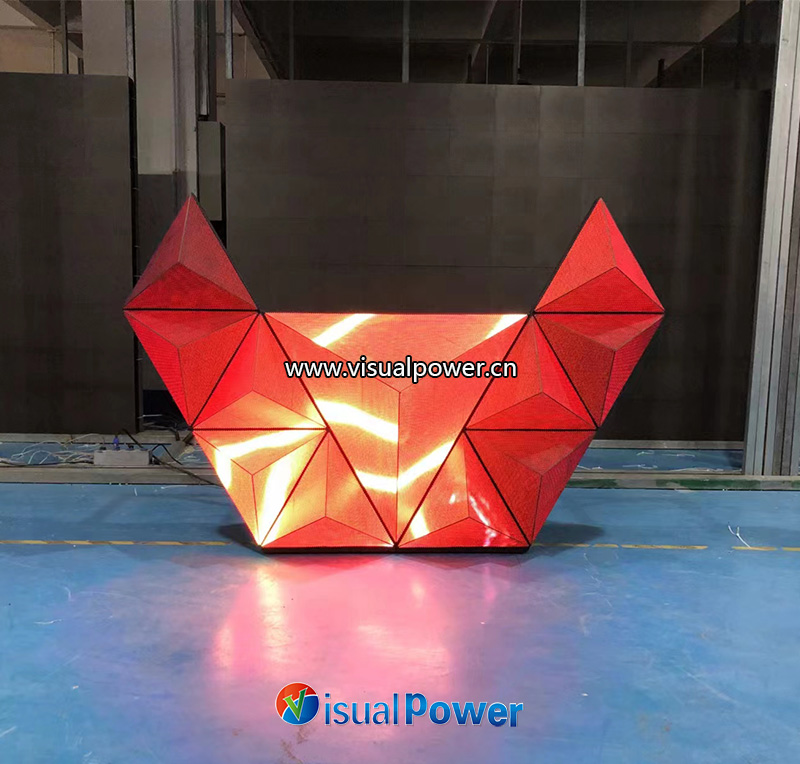Categories
- News (41)
- case study (6)
I first saw the triangle LED display that day at a light design show in Milan. It stood there, its triangular structure like a “restless outlier” among the rows of square screens, but it unexpectedly attracted me. At that moment, I realized that this is not only an innovation of display technology, but also an evolution of expression.
I like everything “unconventional” things, triangle LED display just stepped on my aesthetic point. From that moment on, I was fascinated and began to learn more and more about this unique display solution. Today, I want to write down my exploration experience without reservation, without talking about technical terms, without piling up concepts, only what I know, used, and saw, to tell you.

Why triangles? My initial question about this structure
I once questioned: In this “rectangle is king” display world, triangular LED display can do what? Only later did I realize that this structure brings not only visual freshness, but also a spatial language that breaks stereotypes.
The traditional rectangular screen pays attention to efficiency, while the triangle gives people a sense of rhythm, direction, and even a “spelling pattern” aesthetic. It is like a light and shadow cutter on the stage, but also like the digital graffiti on the outside wall of the building, with a bit of pioneer flavor, but full of freedom.
One of the most stunning examples I’ve seen is a fashion brand that created a “dynamic Mosaic wall” with a triangular screen in its window – multiple angles, irregular combinations, and a picture that changes direction every few seconds, as if the entire store is alive.

What can it be used for? Don’t just think it’s “showmanship.”
Many people see the triangle LED screen the first reaction is: “cool, but I don’t need it?” I used to feel that way, too, and it wasn’t until I actually got involved with a few projects that I realized it could be used in a much wider range of scenarios than I thought.
Retail space: Triangles can break the monotony of traditional window displays, especially in fast fashion, fashion brands, home design brands are very popular. It makes people who “walk by” willing to take a second look and even stop to take a photo.
Exhibition and Installation art: In an interactive art exhibition, I saw an artist create a three-dimensional installation of light with multiple triangular leds. The audience can view it from different angles, and the flow of light changes with the footsteps, making you forget that this is just a “screen”.
Stage background: Music festivals and large shows like it because the triangle is very suitable for “cutting rhythm”. It’s not so rectangular, it flashes and changes color according to the frequency of the music, and the effect is so shocking that it gives me goosebumps.
High-end interior decoration: Some companies like to embed it in the hall wall, play LOGO animation, welcome words or real-time dynamics, not conventional, looks much more advanced than the ordinary horizontal screen.
You think it’s difficult, but it’s not complicated at all
I was also worried about the installation. After all, triangles are not as “honest” as rectangles, and you can’t put them in rows. But now many manufacturers have done modular design, only need infrastructure splicing + standard interface connection on the line, the construction team a little understanding of structural design, you can install beautiful and reliable.
In addition, one thing I particularly want to mention is flexible stitching. Triangles are one of the most basic geometric shapes, which can be endlessly spliced into diamonds, hexagons, honeycombs, and even cubic cubes. This gives designers more room to play than ever before.
I know an architect who, in a subway station public art project, made a “dynamic clock face” with triangular leds. Every minute, the whole triangle group rotates like a gear. It’s so interesting.
Use experience: stable and cool, not a “vase”
Many people worry that this kind of strange LED screen will not “have to look”, in fact, I personally use down, the most surprising thing is its stability and display effect.
Brightness and contrast: it will not be discounted because it is a triangle, the core is still LED lamp bead technology, and the color performance is excellent.
Resolution: Now the mainstream products have done P2.5 or higher, the detail performance is enough to support the dynamic image.
System compatibility: Most control systems have been able to adapt to this form, no additional development is required, as long as the layout is set reasonably, the playback content can be accurately controlled in every corner.
What I personally value most is its programmability – by controlling the software, I can make each triangle unit represent different content, this dynamic stitching feeling, really a bit like the “Lego for the screen”.
Conclusion: Triangle LED Display is a futuristic choice
Ultimately, the triangle LED display for me is not just a technological breakthrough, but a redefinition of expression. It is not something everyone “must have,” but it is destined for those who dare to break through, dare to express themselves, and want to be different.
If you’re a designer, it’s probably the best thing you’ve ever done. If you are the brand owner, it may be your sharpest tool to convey the idea; If you’re just an average person with a fastidious aesthetic, it can also be the most noticeable presence in your space.
I don’t want you to place an order right away, but I want you to know that in a world of “standard screens,” there are corners for those who don’t want to conform.
The triangle, however, happens to be one of the sharpest and freest.